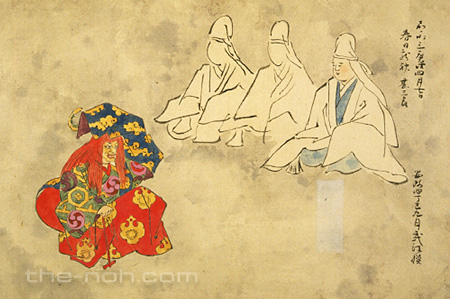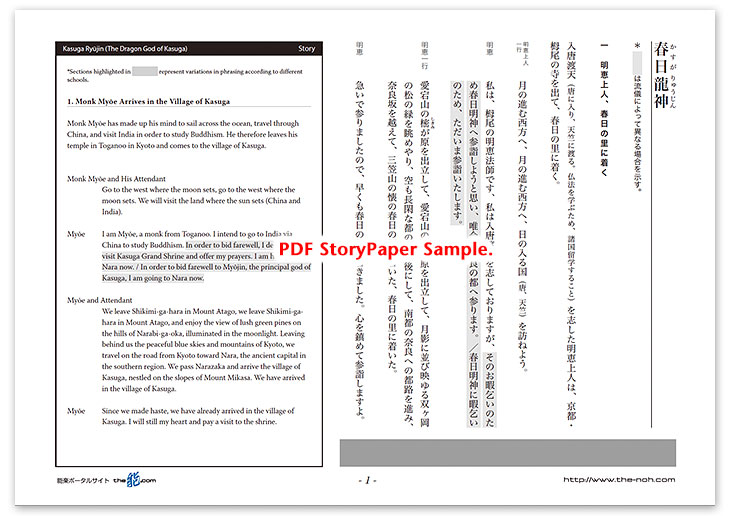
 Kasuga Ryūjin (The Dragon God of Kasuga)
Kasuga Ryūjin (The Dragon God of Kasuga)

![]()
Monk Myōe who resides in a humble hut in Toganoo in Kyoto intends to travel to India via China and visit the holy sites of Buddhism. He goes to Kasuga Grand Shrine in Nara to make a farewell call. In the shrine, Myōe meets an old man who seems to be a priest of the shrine. He exchanges words with the old man and tells him that he is visiting the shrine to bid farewell to the god of Kasuga Myōjin. The old man then warns Myōe that leaving Japan would go against the divine wishes of the god and tries to hold Myōe back. Myōe makes the counter-argument that as he is going to worship the holy sites of Buddhism, he is not going against the god’s wishes. Nevertheless, the old man vigorously persists in trying to persuade Myōe not to leave Japan. The old man recounts that as centuries have passed since Shakyamuni Buddha passed away, there is not much merit to visit India and China nowadays. Besides, Mount Kasuga here is considered to be Vulture Peak. Japan has Mount Hiei, which has been likened to Mount Tiantai, and Mount Kimpu in Yoshino, which has been likened to Mount Wutai. Thus the old man lists a number of sites in Japan considered to be the equivalents of Buddhist holy sites. The old man emphasizes that Buddhism has spread throughout Japan and therefore, Myōe need not leave his home country. While listening to everything the old man has told him, Myōe changes his mind and decides to accept the old man’s words as an oracle from the god of Kasuga Myōjin and stops going to China. The old man promises Myōe that if Myōe decides not to go to China, he will move India to Mount Mikasa and show him the entire life of Shakyamuni Buddha, starting with his mother, Maya, giving birth to him, as well as the moment of his enlightenment in Bodhgaya, his sermon at Vulture Peak, and his death in the grove of sala trees. He mentions that his name is Tokifū Hideyuki and that he came to present this oracle to Myōe. He then vanishes into thin air.
The miraculous power of the oracle is immense. Myōe now witnesses divine light shining forth and illuminating, in gold, all of the mountains and fields of Kasuga. Before Myōe’s eyes, the miracle of trees and grasses being transformed into buddhas is now revealed. Then, dragon gods appear. Because they want to hear Shakyamuni Buddha preach the Lotus Sutra, the Eight Great Dragon Kings, accompanied by their families and retinues, come and sit in an assembly. In addition, other gods appear and similarly sit together in the assembly. Next, female dragons perform dances as scenes from the life of Shakyamuni are reflected on Mount Mikasa. Myōe now firmly determines to abandon his plan to visit China and India to study Buddhism. No matter how many such places as those one might visit, none could surpass this place. So saying, the female dragons leave to the south and the dragon gods leap into Sarusawa Pond. They all vanish.
![]()
In order to fully appreciate “Kasuga Ryūjin,” it will be helpful to have some knowledge about the waki character, Myōe Shōnin (Monk Myōe), a very high-ranking, ordained Buddhist priest of the Kamakura era (1185-1333) who devoted his entire life to ascetic training and the study of Buddhism. He is well-known for his diary, Yume Nikki (A Diary of Dreams), which he continuously wrote from his teenage years to his death at the age of sixty. He was a morally upright man with unparalleled knowledge, deep wisdom, and fine temperament. He did not pander to or curry favor with secular society but who treated everyone with compassion and therefore, many people had great respect for Myōe. He also showed real courage and did not shrink before the powerful, such as when he gave shelter to defeated warriors during the Jōkyū War of 1221. History recognizes Myōe as the restorer of Flower Garland School of Buddhism in Japan. Many books have been published about him. (Some examples are Myōe – Yume wo Ikiru (Myōe – Living a Dream) by Hayao Kawai and Myōe Shōnin (Monk Myōe) by Masako Shirasu.) Please refer to those books to learn more about him.
Kasuga Ryūjin is a story in which a god stops Myōe from going abroad. It is quite a simple story that does not involve much drama. However, it portrays the strong desire to prevent an important man, akin to a national treasure, from leaving the country. In the play, Kasuga Myōjin is described as an incarnation of the Buddha, and therefore Myōe accepts what the old man says as an oracle and refrains from leaving Japan. The story conveys a lesson to all people about the importance of finding your own way in the place you now live, rather than searching for it somewhere else. Deeply experiencing the message of this play gives us the chance to reconsider how we are living our own lives.
The highlight of this piece is the scene in the second half in which the Eight Great Dragon Kings appear. The scene in which each Dragon King is called by name and then manifests his dignified appearance—while the melody is rather simple—is imbued with many entertaining aspects.
STORY PAPER : Kasuga Ryūjin (The Dragon God of Kasuga)
Story Paper presents noh chant stories in modern speech, with story outlines, highlights and more using Adobe PDF format, which can print out and zoom in. Print out the pages and take them with you when you see the actual noh performance.

The copyright of Story Paper is held by the Noh.com. Story Paper is for individual use only. It is prohibited by the copyright law to distribute or publish printed-out Story Paper pages without prior consent. For more information, check the credit and disclaimer pages.



 [Kasuga Ryūjin (The Dragon God of Kasuga) : Story Paper PDF : 523KB
[Kasuga Ryūjin (The Dragon God of Kasuga) : Story Paper PDF : 523KB